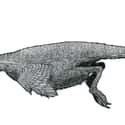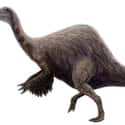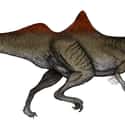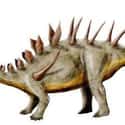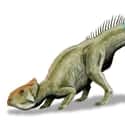-
(#1) Linhenykus Barely Had Arms
Linhenykus monodactylus is a small dinosaur in a group of species known as alvarezsaurs, whose membership consists of bipedal dinosaurs with absurdly tiny arms. This particularly species inhabited the area which would become Mongolia between 84 and 75 million years ago, and it is unique among the alvarezsaurs. Unlike its close relatives, who all have multiple fingers, linhenykus only has the one, heavily-clawed finger. This makes linhenykus the only known dinosaur to possesses a single finger per arm, a trait which is unusual even to this day.
It is unclear exactly why linhenykus and its relatives had such tiny arms, but there is one theory floating around in the paleontological community. It is hypothesized linhenykus used their thick claws to dig at ants hills and termite mounds to break in and feast on the small insects hiding inside. These creatures were very small, able to fit in the palm of your hand, and could have subsisted on an insectivorous diet.
-
(#2) Halszkaraptor Was So Weird Scientists Thought It Was Fake
Halszkaraptor's skeleton appeared so unusual that at first, experts didn't even think it was real. Andrea Cau, an investigator from the University of Bologna, explains:
"It was so strange that we suspected that it might have been a chimera – a mix of different skeletons glued together. It wouldn’t be the first time."
But once the chunk of rock containing the fossil was scanned, the scientists determined that this creature was for real. It seems to have been amphibious, though its features look more like those of a duck or a swan than a reptile. It presumably ate fish.
-
(#3) Incisivosaurus Had Ridiculous Buck Teeth
Possibly one of the most absurd creatures to ever walk the Earth, incisivosaurus is a buck-toothed dinosaur that lived 128 million years ago. This bird-like dinosaur is unique for it’s bizarre teeth, a rare quality in animals outside of mammals. Most reptiles have one type of tooth, but incisivosaurus had both smaller, sharper teeth, as well as their distinctive front teeth. Some scientists believe they were either herbivorous or omnivorous, another trait that makes them distinct.
Amazingly, their strange physiology helped reveal some major secrets about another type of dinosaur, the oviraptor. It was believed oviraptors may have been birds who had simply lost their ability to fly, but it was later discovered incisivosaurus had actually been an early ancestor to the oviraptors, disproving the theory they came from birds.
-
(#4) Therizinosaurus Had The Longest Claws Of Any Animal
Therizinosaurus could be found roaming around in Central Asia between 75 and 70 million years ago. While these monstrous beasts may look like the dinosaur version of Edward Scissorhands, they were probably gentle giants who only used their claws for self defense and to gather food. Their claws are believed to be the longest in animal history, and are able to grow over three feet in length. Unfortunately, a full skeleton has never been discovered for this animal, so there are many unanswered questions as to what the therizinosaurus was really like. Scientists have not even found a skull, so we can’t even be sure of what or how they ate.
-
(#5) Epidexipteryx Is A Terrifying Cousin Of Archaeopteryx
This scary-looking guy was a small, bird-like dinosaur who lived between 152 and 168 million years ago. Although they sported a primitive form of feathers, they are actually not a direct ancestor to birds. However, epidexipteryx helped scientists better understand some of the transitional stages between dinosaurs and birds.
Epidexipteryx could not fly, so researchers believe its feathers may have evolved purely as a form ornamentation, perhaps making them more attractive to prospective mates. However, they may not have been stranded on the ground either. Their hands feature several long, narrow fingers that could possibly have been used to climb or extract insects from trees, much like the modern aye-aye. As epidexipteryx is rather small, it would make sense that an arboreal lifestyle would help in keeping them safe from terrestrial threats.
-
(#6) Deinocheirus Mirificus Was The Subject Of A 50 Year Long Mystery
Perhaps one of the most unusual dinosaurs of all, Deinocheirus mirificus was at the heart of a puzzle in the scientific community since 1965. At first, the only fossils recovered from this dinosaur were a pair of massive arms, which measured almost eight feet in length. The arms were originally found in the Gobi desert, but subsequent expeditions to find the rest of its body were fruitless. That is, until two other skeletons were discovered in 2006 and 2009.
At first, researchers were dismayed to hear poachers had stolen and sold off many parts of the skeletons, including a skull. By a stroke of miraculous luck a man named Pascal Godefroit, a representative of the Royal Belgian Institute of Natural Sciences, remembered seeing some of the stolen fossils and was able to point the investigation in the right direction. They discovered that the fossils had been sold to private collectors in Japan and Germany, and were finally able to put an end to a 50 year mystery.
What scientists learned from the unification of the skeleton was even more shocking than the story of the discovery itself, as Deinocheirus mirificus proved to be one of the most unique dinosaurs in the fossil record. It had a toothless, duck-like bill used to skim water for food, as well as two powerful arms for gathering food and stripping branches from trees. It grew to the size of a tyrannosaurus, and had a massive hump on its back to help its legs support its large body. About 1,400 rocks were found in the belly of one specimen, leading researchers to believe they used them to grind up food in their stomachs, similar to many modern birds.
-
(#7) Concavenator Probably Had Some Back Problems
This odd theropod is Concavenator corcovatus, a carnivorous dinosaur that roamed Europe about 130 million years ago. The noticeable hump on its back is unique for these types of dinosaurs, and it has left scientists puzzled since its discovery in 2003. Researchers have thrown out all sorts of theories about the hump, speculating it could be used for mating, storing fat, or maybe that it was purely decorative. Another one of concavenator’s bizarre features are the bumpy protrusions on its arms.
These are similar to the anchor points for modern bird feathers, but scientists believed concavenator most likely had non-scale protrusions that dangled from them. The debate is still ongoing as to the true nature of these strange knobs.
-
(#8) Carnotaurus
- Organism Classification
Carnotaurs have a devilish reputation - that's because they sport a set of distinctive horns unique among large, carnivorous theropods. Even the name carnotaurus translates from Latin as “meat-eating bull,” a direct reference to their horns and vicious appearance. What made them even more deadly were their powerful leg and tail muscles, which allowed them to sprint in short, rapid bursts of speed.
While its horns are one of carnotaurus’s defining features, a subtler feature may prove to be even more bizarre. Carnotaurus had remarkably short arms that measure only a foot and half long - tiny compared to the rest of its body. They are much shorter than those of the T. rex, another theropod known for their small arms. Scientists believe their arms were most likely vestigial remnants and probably served no real purpose in their day-to-day lives.
-
(#9) Pachycephalosaurus Wears A Natural Helmet
The pachycephalosaurus is famed for it’s remarkably thick skull, the top of which is a bony dome that is some nine inches thick. Amazingly, their skulls are known to transform in shape as they age, fooling many scientists for a while into believing the different life stages of these animals were actually completely different species.
It is hypothesized these dinosaurs used their hardened skulls to butt heads with rivals over mates, although some scientists believe their vertebrae could not have been strong enough to survive these impacts without causing serious injury. The debate has raged in the paleontological community since the discovery of these creatures, and many studies have been conducted to try and figure this out. One study showed that up to 22% of all species of pachycephalosaurus show signs of cranial injury, giving more credence to the theory they were natural head-butters. Others believe the domes were purely ornamental, but it doesn't seem like we will get a definitive answer anytime soon.
-
(#10) The Kentrosaurus Puts Porcupines To Shame
Kentrosaurus takes the armored spines made famous by its cousin the stegosaurus and pushes the idea one step further. Not only do they sport the iconic vertical plates on their shoulders, but those plates transform into deadly spikes as they travel down the kentrosaurs back. Two of those spines jut directly out of their front legs, and the ones on its tail can be swung around like a prehistoric morning-star. These incredibly badass tail-spikes go by the equally badass name "thagomizers."
These massive herbivores get their name from their distinctive spikes, which evolved to pose a formidable challenge for potential predators. Researchers have studied the physics behind the kentrosaurs body to better understand just how powerful they may have been, and the results are fascinating. The kentrosaurus had a flexible skeleton that allowed it to move and turn with ease, ensuring predators couldn’t sneak up on them. They used their long, muscular tails as massive spiked clubs and could swing them at a maximum speed of 89 mph. Paleontologist Heinrich Mallison described the force as powerful enough to shatter ribs and pierce flesh, and even said the speeds achieved by the tail were “greater than those sufficient to fracture a human skull.”
-
(#11) Leptoceratops Was An Adorable Ceratopsian
These petite ceratopsians were a contemporary of their cousin, the triceratops, and the two could be found throughout North America. Unlike the triceratops, they had no horns and ran around on two legs. It’s an interesting bit of natural history that all dinosaurs started out as bipedal, and then many independently evolved the quadruped form. As herbivores, the leptoceratops would scurry on the ground, rooting up vegetation with their pronounced beak. They lived at the very end of the dinosaurs time on earth, only existing for about 50 million years before the extinction event that ended the Cretaceous period and wiped out nearly all of the dinosaurs.
-
(#12) Pachyrhinosaurus Lived Around The North Pole
Unlike their close relative the triceratops - known for their massive facial horns - the pachyrhinosaurus has a mass of knotted bone right in the center of their face. This is fairly rare in large ceratopsians, a group of dinosaurs whose name translates from Greek as “horned face.”
Contrary to the popular myth that dinosaurs only lived in equatorial, swamp-like environments, research proved some dinosaurs managed to make their homes as far north as the North Pole. Pachyrhinosaurus was one of a handful of species discovered in a fossil bed in Alaska, an important find that has helped shed light on dinosaur diversity. About 70 million years ago, northern Alaska was even closer to the North Pole than it is today, meaning these dinosaurs may have experienced periods of up to four months without any sunlight. Still, the warmer climate of the time meant the pole wasn’t all frozen wasteland, but actually filled with temperate forests marked with ferns and pine trees.
-
(#13) Neuquensaurus Was Covered In Armored Plates
Neuquensaurus was a relatively small member of the titanosaur family, a group of dinosaurs known for their tremendous size and elongated necks. These hefty sauropods roamed throughout Patagonia near the end of the Cretaceous period and were very common for their time. Though credible sources can be difficult to find, neuquensaurus was believed to have armor-like osteoderms speckled across its back. This is rare in long-necked dinosaurs and, given their smaller stature, it is reasonable to believe they may have served as a form of protection against larger predators.
-
(#14) Oviraptors Were Mistakenly Thought To Be Freaky Egg Thieves
These bizarre dinosaurs have long been misunderstood by the scientific community, but the misconceptions are finally being addressed. After an oviraptor skeleton was discovered near a nest of fossilized dinosaur eggs, a theory emerged suggesting oviraptors might have been specialized egg thieves. Scientists thought the discovered oviraptor was caught in the act and killed by a protective mother. Its unusual, beak-like mouth was pointed to as further evidence that oviraptors fed by cracking open eggs and slurping out the contents. While that’s all gross and fascinating, it turns out that it’s not actually true.
The eggs discovered with the oviraptor were mistakenly believed to belong to a protoceratops, a small dinosaur related to the much larger and more famous triceratops. However, subsequent discoveries indicate the eggs did not belong to the small ceratopsian, but actually the oviraptor itself. While the evidence once characterized oviraptors as heartless baby stealers, that idea has morphed into quite the opposite. We now know these theropods were devoted mothers who chose to stay and look after their nests.
-

(#15) Dineobellator Is Thought To Be One Of The Last Known Surviving Raptor Species
Dineobellator was a formidable predator and boasts the battle scars to prove it. https://t.co/13loECSMkE
— Smithsonian Magazine (@SmithsonianMag) March 26, 2020In 2008, paleontologist Robert Sullivan of the New Mexico Museum of Natural History and Science in Albuquerque, NM, collected the fossils of a previously unknown dinosaur species that, as of March 2020, is considered one of the last known surviving raptors. Dr. Steven Jasinski of the University of Pennsylvania, a member of Sullivan's team, named the species "Dineobellator notohesperus," which means "Navajo warrior from the Southwest," according to Futurity.
The Dineobellator is thought to have been about 3 feet wide, 6 to 7 feet long, and covered in feathers, at least on its forearms, where scientists found "quill nobs" in the recovered bones. The researchers studying the fossil also suspect it might have used its hands to hold smaller prey, such as lizards and birds. Perhaps the dinosaur's most unique feature is its flexible tail; most raptors are thought to have had straight, stiffened tails.
New Random Displays Display All By Ranking
About This Tool
Everyone knows that dinosaurs are mysterious prehistoric animals with the longest history on this planet. With the new discoveries made by archaeologists over the years, the history of dinosaurs has gradually been rewritten and corrected. These fascinating animals have frequently appeared in film and television works for many years, and most of them have peculiar and weird appearances, satisfying the human imagination of dinosaurs.
With lots of historic archaeological discoveries over the decades, scientists have revealed more facts about the existence of weird dinosaurs. Here the random tool introduced 15 of the most bizarre dinosaurs that ever lived on the planet.
Our data comes from Ranker, If you want to participate in the ranking of items displayed on this page, please click here.











